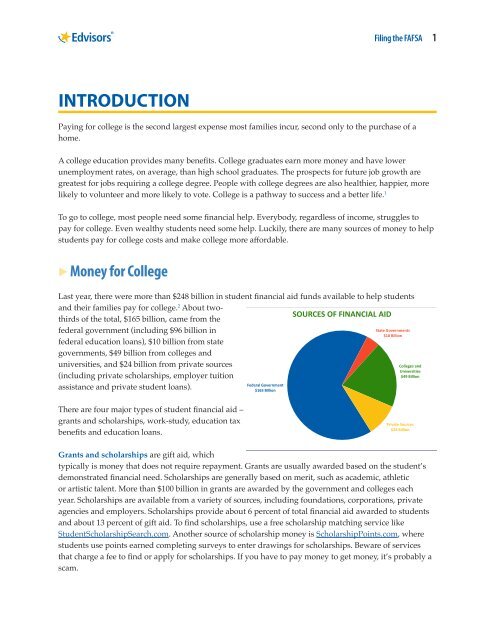filing-the-fafsa-2015-2016-edition
filing-the-fafsa-2015-2016-edition
filing-the-fafsa-2015-2016-edition
You also want an ePaper? Increase the reach of your titles
YUMPU automatically turns print PDFs into web optimized ePapers that Google loves.
Filing <strong>the</strong> FAFSA 1<br />
INTRODUCTION<br />
Paying for college is <strong>the</strong> second largest expense most families incur, second only to <strong>the</strong> purchase of a<br />
home.<br />
A college education provides many benefits. College graduates earn more money and have lower<br />
unemployment rates, on average, than high school graduates. The prospects for future job growth are<br />
greatest for jobs requiring a college degree. People with college degrees are also healthier, happier, more<br />
likely to volunteer and more likely to vote. College is a pathway to success and a better life. 1<br />
To go to college, most people need some financial help. Everybody, regardless of income, struggles to<br />
pay for college. Even wealthy students need some help. Luckily, <strong>the</strong>re are many sources of money to help<br />
students pay for college costs and make college more affordable.<br />
▶ Money for College<br />
Last year, <strong>the</strong>re were more than $248 billion in student financial aid funds available to help students<br />
and <strong>the</strong>ir families pay for college. 2 About twothirds<br />
of <strong>the</strong> total, $165 billion, came from <strong>the</strong><br />
federal government (including $96 billion in<br />
federal education loans), $10 billion from state<br />
governments, $49 billion from colleges and<br />
universities, and $24 billion from private sources<br />
(including private scholarships, employer tuition<br />
assistance and private student loans).<br />
Federal Government<br />
$165 Billion<br />
SOURCES OF FINANCIAL AID<br />
State Governments<br />
$10 Billion<br />
Colleges and<br />
Universities<br />
$49 Billion<br />
There are four major types of student financial aid –<br />
grants and scholarships, work-study, education tax<br />
benefits and education loans.<br />
Private Sources<br />
$24 Billion<br />
Grants and scholarships are gift aid, which<br />
typically is money that does not require repayment. Grants are usually awarded based on <strong>the</strong> student’s<br />
demonstrated financial need. Scholarships are generally based on merit, such as academic, athletic<br />
or artistic talent. More than $100 billion in grants are awarded by <strong>the</strong> government and colleges each<br />
year. Scholarships are available from a variety of sources, including foundations, corporations, private<br />
agencies and employers. Scholarships provide about 6 percent of total financial aid awarded to students<br />
and about 13 percent of gift aid. To find scholarships, use a free scholarship matching service like<br />
StudentScholarshipSearch.com. Ano<strong>the</strong>r source of scholarship money is ScholarshipPoints.com, where<br />
students use points earned completing surveys to enter drawings for scholarships. Beware of services<br />
that charge a fee to find or apply for scholarships. If you have to pay money to get money, it’s probably a<br />
scam.


